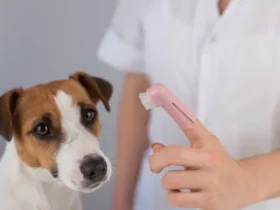If you’ve noticed your dog scooting across the floor, it might be more than just a quirky habit. This behavior can be a sign of an issue with your dog’s anal glands. In this blog, we’ll explore the role of anal glands, why they might cause scooting, and practical steps you can take to help your furry friend.
Understanding Dog Anal Glands
Dog anal glands, also known as anal sacs, are two small glands located on either side of your dog’s anus. These glands produce a smelly fluid that is typically expressed during defecation. This fluid is believed to help dogs mark their territory and communicate with other dogs.
Function and Anatomy
- Location: The anal glands are located at approximately 4 o’clock and 8 o’clock positions around the anus.
- Fluid Production: The glands secrete a strong-smelling fluid that’s mixed with fecal matter when your dog defecates.
- Expression: In a natural setting, these glands are expressed through the pressure of the stool during bowel movements.
Why Dogs Scoot: The Role of Anal Glands
Scooting is when a dog drags its rear end across the floor, usually in an attempt to relieve discomfort. This behavior often points to problems with the anal glands. Here’s why:
- Impaction: If the anal glands don’t empty properly, the fluid inside can become thick and sticky. This impaction can cause discomfort and lead to scooting as your dog tries to alleviate the pressure.
- Infection: Bacteria can infect the anal glands, causing inflammation and pain. Infected anal glands may lead to swelling, which can make your dog feel the urge to scoot.
- Abscess: In severe cases, impacted or infected anal glands can form abscesses. These are painful and can cause significant discomfort, prompting your dog to scoot.
- Anal Gland Tumors: Though less common, tumors in the anal glands can cause discomfort and lead to scooting. Regular veterinary check-ups can help in early detection.
How to Help Your Dog with Scooting Issues
Addressing anal gland problems involves several steps, from simple home remedies to professional veterinary care. Here’s a comprehensive guide:
1. Monitor and Identify Symptoms
Keep an eye on your dog for signs of anal gland problems:
- Frequent scooting or dragging of the rear end.
- Excessive licking or biting of the anal area.
- A strong, unpleasant odor around the anus.
- Visible swelling or redness around the anus.
2. Check for Signs of Discomfort
Observe if your dog shows signs of pain or discomfort, such as whining or difficulty sitting. If you notice any of these symptoms, a vet visit is warranted.
3. Consult Your Veterinarian
If you suspect your dog’s scooting is related to anal gland issues, consult your veterinarian. They can perform a physical examination and may express the anal glands manually if needed. They will also check for infections, abscesses, or tumors.
4. Professional Anal Gland Expression
Regular anal gland expression by a vet or professional groomer can help prevent impaction. Depending on your dog’s needs, this may be done every few weeks to months.
5. Maintain Proper Hygiene
- Regular Bathing: Bathing your dog regularly can help keep the anal area clean and free from irritants.
- Grooming: Regular grooming, including trimming around the anal area, can help in maintaining hygiene.
6. Dietary Adjustments
A diet high in fiber can help produce firmer stools, which can naturally express the anal glands during defecation. Consult your vet about incorporating fiber-rich foods or supplements into your dog’s diet.
7. Home Remedies
In addition to professional care, you can use some home remedies to alleviate discomfort:
- Warm Compresses: Applying a warm compress to the anal area can help soothe inflammation and encourage drainage.
- Topical Treatments: Some over-the-counter creams or ointments may provide temporary relief from discomfort.
8. Preventive Measures
To prevent future issues with anal glands:
- Regular Vet Check-Ups: Regular veterinary visits will help monitor your dog’s anal gland health.
- Healthy Weight: Maintaining a healthy weight reduces the risk of anal gland issues. Obesity can put extra pressure on the anal glands.
- Adequate Exercise: Regular exercise ensures healthy bowel movements, which can aid in natural anal gland expression.
When to Seek Immediate Veterinary Attention
If your dog shows severe signs of distress, has a noticeable growth around the anus, or if home remedies and professional care don’t improve the situation, seek immediate veterinary attention. Infections, abscesses, or tumors require prompt treatment to prevent further complications.
Conclusion
Scooting is often a sign of anal gland issues in dogs, but with proper care and attention, you can help alleviate your dog’s discomfort and prevent future problems. By understanding the role of anal glands, monitoring your dog’s behavior, and seeking professional help when needed, you can ensure your furry friend remains healthy and happy.
Regular check-ups and proper hygiene are key to preventing anal gland problems. Always consult with your veterinarian for personalized advice and treatment options.
By addressing anal gland issues proactively and maintaining good hygiene and dietary practices, you can keep your dog comfortable and scoot-free.











Leave a Reply